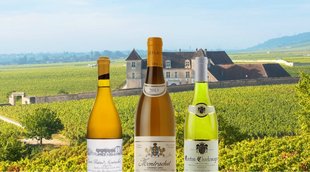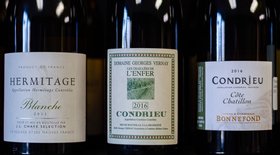White Burgundy Wine (Types, Prices, 10 Best Bottles to Buy in 2025)
Want to add an elegant white Burgundy to your wine collection?
White Burgundy wines are revered for their intensity and finesse by wine connoisseurs worldwide. Chardonnay grapes are grown worldwide, but they’re known to find their best expression in these Bourgogne wines!
These exceptional whites also frequently get auctioned off at enviable prices making them ideal additions to your wine cellar.
In this article, we’ll explore all about these wines, where the best white Burgundy wines come from, their characteristics, the loveliest vintages, and the best ones to buy in 2024.
You’ll also discover the easiest way to buy, store, and sell your white Burgundy wines.
Further reading
- Check out 13 Outstanding Burgundies that deserve a place in your wine portfolio!
- Discover the Best Wine Brands from the most prestigious wineries across the world.
- Explore 9 Impressive Chenin Blanc Wines to try this festive season.
All About White Burgundy Wine
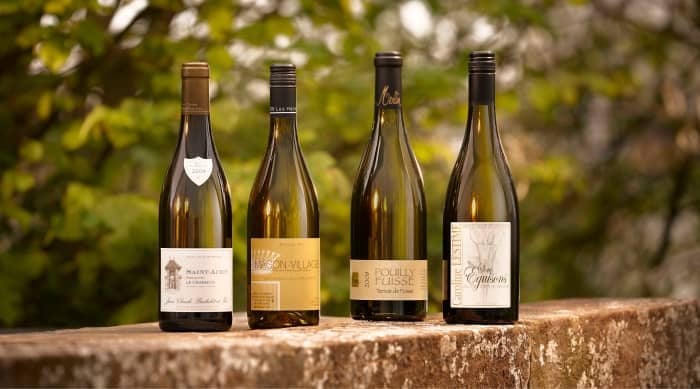
White Burgundy wine (Bourgogne blanc) is made in the French wine region of Burgundy.
Most white Burgundy wines are made with Chardonnay grapes.
However, a very small percentage of white Burgundy wines are made with other grape varieties like Aligoté, Pinot Gris, and Pinot Blanc.
Burgundy wine producers also make excellent red wine (Bourgogne rouge), which are made with the Pinot Noir grape variety.
How Are White Burgundy Wines Different from Other White Wines?
The main difference is that white Burgundies undergo a secondary malolactic fermentation after the initial fermentation in oak barrels. This turns the malic acid in the juice to lactic acid, making white Burgundy wines smoother than the others.
But how did it all start?
A Brief History of White Burgundy Wine
Winegrowing in the Burgundy region dates back to the second century AD.
In the middle ages, wine production was mostly supported by monks of the Roman Catholic Church who even built the largest vineyard in the region in 1336.
In the 14th century, the Dukes of Burgundy banned the export of non Burgundy wines to the European market. This significantly boosted the popularity of Burgundy wines.
This popularity of Burgundy wine increased further when the transportation system and roads in France were improved.
In the 17th century, bourgeoisie families bought many of the famous Burgundy vineyards.
In the 1980s, vineyard production quantities increased drastically, but at the cost of compromising the wine’s flavors.
This made a lot of wine producers revamp their winemaking processes to create more complex French wines. That resulted in the production of richer Burgundy whites with creamier textures and enhanced flavors.
What Are the Best Food Pairings With White Burgundy Wine?
White Burgundies pair perfectly with various kinds of meat and seafood such as chicken, beef, crab, salmon, and scallops.
You can also relish a glass of white Burgundy wine alongside mushroom risotto and cauliflower steaks.
Now, let’s look at the terroir from where these delicate white wines emerge.
White Burgundy Wine Regions
The terroir of Burgundy is what makes these whites tick! In fact, white Burgundies are all about terroir - the native Chardonnay grapes, soil, climate, and the ingenuity of the winemakers.
Burgundy’s climate consists of hot summers, cold winters, and unpredictable weather. At times there can be rain, hail, and even frost around the time of harvest. The inconsistent climate is the reason why Burgundy wine vintages vary considerably.
Further, the Burgundy wine region runs from Auxerre in the north to Mâcon in the south.
The four main winemaking areas are:
- Chablis (in the north)
- Côte d'Or (southeast of Chablis)
- Côte Chalonnaise (further south)
- Mâconnais (the southernmost one)
These winemaking zones are divided into 100 appellations that have different terroir characteristics. Let’s go over them in detail:
1. Chablis
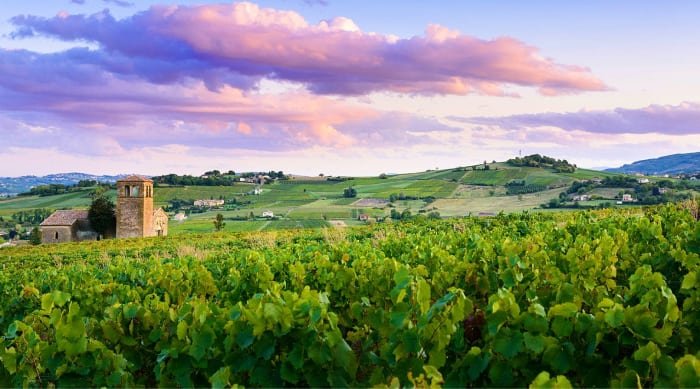
Wines from the Chablis wine region are made with 100% Chardonnay grapes. Chablis is the northernmost area in the Burgundy region where the climate is a bit colder, similar to the one in the Champagne region.
The Chardonnays that come from Chablis are typically lean and unoaked with high acidity and medium body. The typical Chablis wine is usually fruity with notes of citrus fruit and zest minerality.
2. Côte d'Or
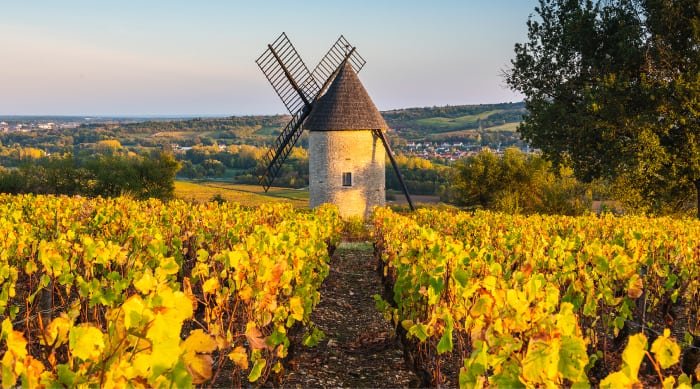
85 miles south-east of Chablis is the Côte d'Or (golden slope) region - home to some of the most famous and expensive Grand Cru Burgundy wines!
Côte d'Or is split into two parts:
A. Côte de Nuits
The Côte de Nuits area starts just south of Dijon and ends at the village of Corgoloin.
Côte de Nuits has 24 Grand Cru vineyards, and 80% of the wine produced here is red from Pinot Noir grapes. The rest is either white or rosé.
Many of these Grand Cru wines age for decades and are sometimes valued at thousands of dollars.
Most of the red Burgundy wines are full-bodied with ripe fruit notes of cherry, red fruits, and black currant.
B. Côte de Beaune
Côte de Beaune is named after the Beaune village. Maison Louis Latour is the largest Grand Cru winemaker in the area.
Seven out of the eight Grand Cru white Burgundy wines in the entire Burgundy region are produced here.
Some of the most famous white wine villages are Chassagne-Montrachet, Puligny-Montrachet (a producer of some of the best Montrachet wines), Meursault, Volnay, Beaune, and Corton.
The white Burgundy wines from this area are fleshier with fruity flavors of apple, yellow plum, and a fresh earthy aroma.
3. Côte Chalonnaise
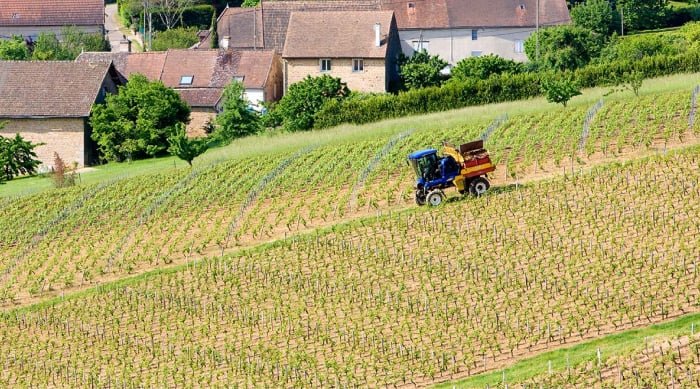
A less famous neighbor of Côte d'Or, Côte Chalonnaise has a number of wineries that produce red, white, and sparkling wines.
The stunning white and rosé sparklers, Crémant de Bourgogne, are made in the village of Rully. This bubbly has a creamier texture than most traditional sparkling wines like Champagne and Asti Spumante.
4. Mâconnais

Mâconnais has a much warmer climate than the other regions. The harvest in this area starts two weeks earlier than the one in Chablis.
The most famous area in Mâconnais is Pouilly-Fuissé - close to the border with the Beaujolais region that’s famous for its Gamay grape cultivation.
Most wines produced in Mâconnais are made with the Chardonnay grape varietal, and have fruity notes of pineapple and green apple with light peach aromas.
Eager to explore a few other and some lesser known Burgundy white wines?
5. Other Burgundy Whites
Besides the Burgundy wines made with 100% Chardonnay grapes, there are some others produced in smaller quantities.
- Aligoté wines: They’re mainly produced in Bouzeron and have to be made with at least 85% Aligote grapes and no more than 15% Chardonnay.
- Pinot Blanc: These white Burgundy wines are mainly made in Nuits-St-Georges in the Côte d'Or region.
- Pinot Gris: It is a white grape variety that’s a mutation of Pinot Noir.
- Sauvignon Blanc: This white Burgundy wine is made in the Saint-Bris appellation.
Next, we’ll take a closer look at the different white Burgundy wine classifications and what sets them apart.
Burgundy Wine Classifications and Characteristics
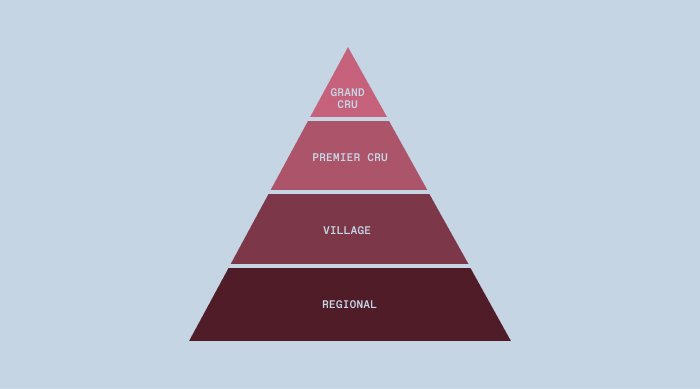
There are four main white Burgundy wine classifications:
1. Grand Cru Burgundy
Grand Cru wines make up only 2% of the Burgundy wine production. They’re produced in small numbers by the best vineyards in the Burgundy region as regulated by the appellations d'origine contrôlée (AOC).
Grand Cru wines are meant for cellaring, with some of them aging beautifully for over 15 years.
The wine label of such wines indicates the class “Grand Cru,” the appellation, and the vineyard but doesn’t have the village’s name where it was produced.
2. Premier Cru Burgundy
Premier Cru wines make up about 12% of the total Burgundian wine production and are also of high quality but not as well regarded as the Grand Cru Burgundy wines.
Premier Cru wines can age for 3-5 years, while some of the best ones can age for longer.
Premier Cru wine labels usually have the name of the village and the vineyard. If the wine was made with grapes from several vineyards, the label would identify only the village name.
3. Village Wines
Village wines account for 36% of all Burgundy wines and are made from different vineyards or one unclassified vineyard situated close to one of the 72 villages in Burgundy. Village wines can age for 2-4 years.
Village wine labels indicate the village where the wine was produced and the vineyard (if the wine was produced by one vineyard only).
4. Regional Wines
The remaining Burgundy wines (about 50%) are made with grapes from a larger area or across the entire region.
The previous categories produce only red and white wines, while the regional wines classification also includes some rosés and sparkling wines and wines made of grapes other than Chardonnay and Pinot Noir.
There are three regional wine appellations:
- AOC Bourgogne is a standard appellation for red and white wines, which are similar to the ones made in the village appellation. You can drink them within three years of their production date.
- Subregional appellation covers parts larger than one village. These are communes that are not included in a village appellation. Mâcon-Villages and Bourgogne Hautes-Côtes de Beaune are great examples. The subregional appellation is sometimes described as the intermediary between AOC Bourgogne and the village appellation.
- Wines of specific styles or grape varieties such as Aligoté and Crémant de Bourgogne.
Want to get hold of the most highly coveted white Burgundy vintages?
Which Are The Best White Burgundy Vintages?
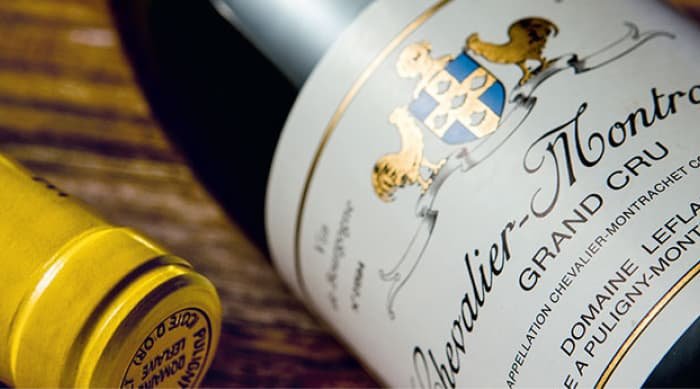
Since the climate can be harsh and the weather unpredictable, some white Burgundy vintage years are better than others.
Here are some main distinctions between the best vintage years:
- 2011-2013: Wines from these years are of stellar quality, despite the difficult season and the harsh weather.
- 2010: A strong vintage year that produced age-worthy wines with richer flavors.
- 2009: The year of 2009 was warm and produced some of the ripest and richest wines and vintage to the taste of any new world Chardonnay wine lover.
- 2008 and older: 2008 was colder and produced crispier wines with a variety of fresh flavors.
- 1990-2003: Some white Burgundy wines from these vintage years suffered from premature oxidation. Such wines lost their flavor and aged too fast. This happened with mostly high-end wines like Grand Cru vineyard wines from the Côte d’Or region.
So, which are the best wines that you can add to your wine collection?
10 Exquisite White Burgundy Wines (Including Tasting Notes, Prices)
Here’s a handpicked selection of white Burgundies that you should look out for:
- 2013 Domaine Leflaive Montrachet Grand Cru
- 2011 Leroy Domaine d'Auvenay Criots-Batard-Montrachet Grand Cru
- 2009 Coche-Dury Corton-Charlemagne Grand Cru
- 2016 Domaine Ramonet Montrachet Grand Cru
- 2015 Domaine de la Romanee-Conti Montrachet Grand Cru
- 2017 Domaine des Comtes Lafon Montrachet Grand Cru
- 2010 Coche-Dury Genevrieres
- 2015 Domaine Leroy Corton-Charlemagne Grand Cru
- 2017 Domaine Francois Raveneau Les Clos
- 2016 Domaine Comte Georges de Vogue Musigny Blanc Grand Cru
1. 2013 Domaine Leflaive Montrachet Grand Cru ($21,440)
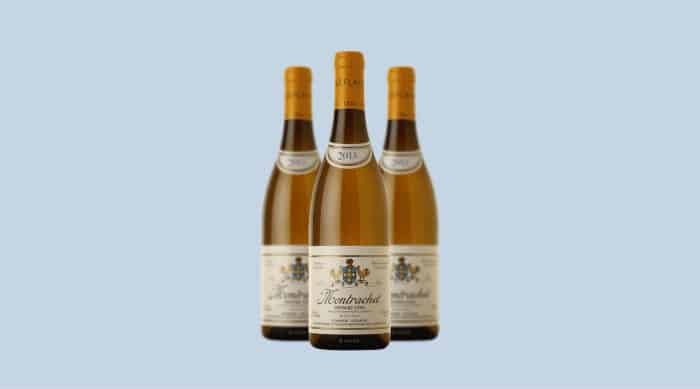
Domaine Leflavie Grand Cru vineyard in Puligny-Montrachet is one of most important wine producers in Côte de Beaune.
This elegant oaked Grand Cru wine is dry and acidic with distinctive citrus fruit aromas accompanied by caramel and oaky notes.
2. 2011 Leroy Domaine d'Auvenay Criots-Batard-Montrachet Grand Cru ($22,395)

This exquisite wine has a mesmerizing pale yellow-gold color and a complex but yet delicate bouquet of aromas. The wine has a strong stone fruit taste of peach and nectarine, accompanied by a slight citrus aroma and an oaky aftertaste.
3. 2009 Coche-Dury Corton-Charlemagne Grand Cru ($6,815)

This rich wine has an elegant intensity of fruity flavors and can age well when stored perfectly. This Grand Cru has a mild citrus and pineapple flavor and a hint of honey with a long-lasting finish of truffles and minerals.
4. 2016 Domaine Ramonet Montrachet Grand Cru ($4,287)

This is a rich Chardonnay wine with complex, layered aromas with fresh, intense, and long-lasting flavors.
This Grand Cru is a delicate combination of minerality, acidity, and rich syrupy texture. You’ll find a slight lemon and tangerine aroma with a taste of honey, butter, and a hint of caramel.
5. 2015 Domaine de la Romanee-Conti Montrachet Grand Cru ($20,481)
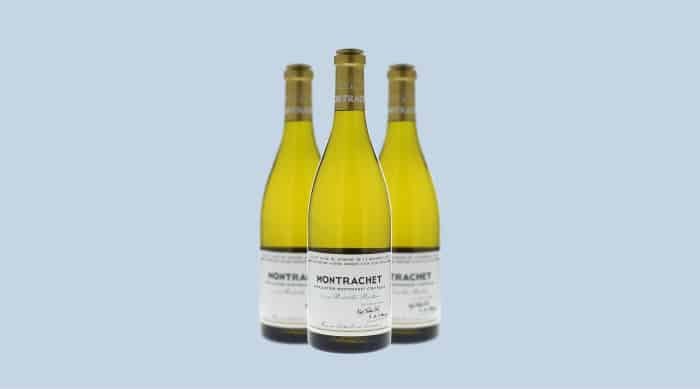
This Montrachet Grand Cru has a bright gold color and soft but firm notes and a lasting finish. This white Burgundy wine has a soft orange flavor with a hint of honey, smoke and minerals and a long-lasting finish of ripe peach and apricot.
6. 2017 Domaine des Comtes Lafon Montrachet Grand Cru ($4,193)

This full-bodied Grand Cru has a creamy texture with a tangy and long pure aftertaste. This elegant golden wine fermented in oak barrels has a good aging potential and can be enjoyed in the years to come.
Every sip of this wine gives you a bouquet of flavors like mandarin oil, toasted nuts, and a hint of lemon.
7. 2010 Coche-Dury Genevrieres ($3,502)
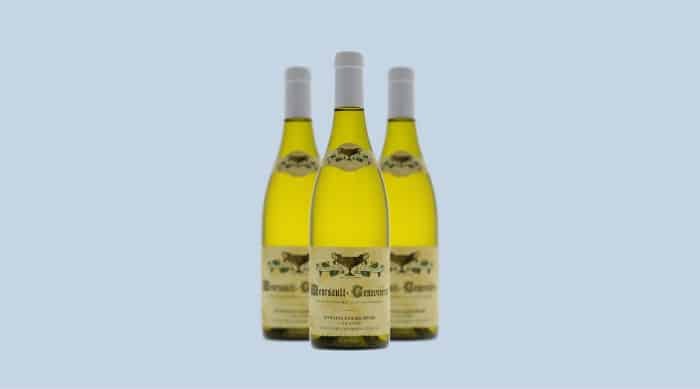
This white Burgundy wine brings a perfect harmony of flavors on the palate and has balanced acidity with a long-lasting crisp taste. The Premier Cru from 2016 has an oily yet airy texture and brings a balanced combination of ripe fruit aromas.
8. 2015 Domaine Leroy Corton-Charlemagne Grand Cru ($62,999)

An exquisite Grand Cru that has a dark golden hue and a silky texture. This wine is full-bodied and powerful, with a superb complexity of ripe tropical fruit flavors and a hint of minerals and smoke.
9. 2017 Domaine Francois Raveneau Les Clos ($2,175)
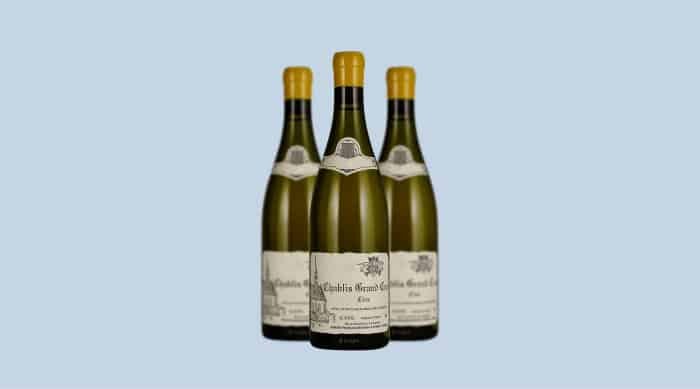
François Raveneau wines are famous for their longevity. The colder climate where the grapes grow contribute to this wine’s crispness and acidity. This Grand Cru wine is fresh, elegant, and complex with a strong mineral taste and a crisp orange flavor.
10. 2016 Domaine Comte Georges de Vogue Musigny Blanc Grand Cru ($1,484)

This mildly acidic Grand Cru from Cote de Nuits is full-bodied, dry, and can age very well. On the palate, citrus and pear flavors are distinctive, followed by a spicy finish of white pepper and ginger.
Wondering where you can buy the best white Burgundy wines from?
Given the wide range of white Burgundies, it's tough to choose one from wine stores or wine auctions and be sure that you’re buying it at the best prices. Not to mention the risk of getting a counterfeit bottle!
Add to it, the nitty gritties of shipping it safely to your cellar, and storing it safely for years. All this makes buying white Burgundies a complicated exercise!
Luckily, you can easily buy an authentic bottle of white Burgundyand other rare wines through Vinovest.
Buy the Best White Burgundy Wines and Other Investment Wines Through Vinovest

Vinovest is an online wine investment platform that will help you buy, sell, authenticate, and store your wines for you.
How it Works
Investing in wines through Vinovest is simple. You just have to:
- Sign up on the Vinovest website.
- Fill up a questionnaire that will assess your investment preferences and risk tolerance.
- Add funds to your account (a minimum of $1,000).
- Track your fine wine portfolio from the comfort of your home.
Benefits of Buying Wines through Vinovest
There are many reasons why buying, selling, and storing your wines with Vinovest is the best way to build your wine portfolio.
- Easy Buying and Selling: Vinovest offers a powerful AI-based platform which enables you to buy and sell your wines with just a few clicks.
- Best Prices: Vinovest sources its wines from wine exchanges, private wineries, and wholesalers from Napa Valley to Chile. This way, you can buy wines at the best possible prices out there!
- Provenance and Authenticity: Vinovest authenticates every single bottle for you before you buy it, so you’ll never get a counterfeit bottle or an improperly stored one.
- Curated Portfolio: An expert team of Sommeliers and data scientists curates your portfolio with the help of financial models backed up by historical data.
- Optimal Storage: Vinovest ensures your wines are stored in a regulated environment in bonded warehouses that are close to the best wine regions in the world. Rest assured, your bottles will be stored at the right temperature, light, humidity, and vibration.
- Insurance: All warehouses have power back-up in case of a power cut. Additionally, each warehouse has 24/7 surveillance cameras, so you know that your wine will always be safe.
You also get an insurance policy at market value, portfolio management, and advice on how to sell your wine at the best possible price. And you get tax advantages since bonded warehouses don’t charge VAT and excise duties.
- Easy Delivery: Once you sell your wine, Vinovest takes care of the delivery to the buyer. And if you want to open your bottle of Olivier Leflaive white Burgundy wine or your California Chardonnay for your next big celebration, Vinovest will deliver it to your doorstep.
- Ownership: And the best part is that you own all the wine you buy through Vinovest!
Celebrate Good Times With White Burgundy Wines!

White Burgundy wines are some of the most elegant and sophisticated wines that you can taste today. They vary in taste, depending on their vintage year and the area where they’re produced.
Vinovest is your best bet to help you find the right wine bottles at the right prices, have them stored impeccably for years, and to sell them later at a profit.
So, why not sign up with Vinovest and start adding the best white Burgundy wines to your portfolio?
